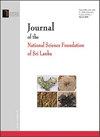Spatial and temporal changes of land use land cover distribution in selected sites of the southern coastal zone of Sri Lanka
IF 0.4
4区 综合性期刊
Q4 MULTIDISCIPLINARY SCIENCES
Journal of the National Science Foundation of Sri Lanka
Pub Date : 2023-06-30
DOI:10.4038/jnsfsr.v51i2.11101
引用次数: 0
Abstract
The southern coastal zone of Sri Lanka has been subjected to a variety of natural and anthropogenic influences over the past three decades. Understanding impacts of such influences on Land Use Land Cover (LULC) is vital for proper management of the coastal zone. This study, therefore, focused on mapping the change/s in the distribution of selected LULC in the selected sites, Bundala, Galle, Kalametiya, and Hambantota of the southern coastal zone, over last 24 years using satellite imagery. LULC maps of nine classes (mangrove, inland vegetation, marsh and grass, sand, bare land, built-up, cultivation, water, and unclassified) were created by employing an on-screen digitization technique achieving an accuracy of >70%. Trend analysis and two-sample proportion tests were used for statistical analyses, whereas geometric calculations were used for descriptive analyses. The results showed the highest overall change in LULC in Kalametiya, followed by Hambantota, Galle, and Bundala. The changes in the LULC classes are mainly attributed to the conversion of water to mangroves, marsh and grass areas in Kalametiya, water to built-up areas in Hambantota, cultivations to built-up areas in Galle, and marsh and grass areas to bare lands in Bundala. The causes of LULC changes were site specific. Trend analyses indicate the least LULC changes in Bundala possibly by 2025. The study highlights the significance of taking into account geographical dislocations when considering and anticipating the potential impacts of development projects over broader extents.斯里兰卡南部沿海地区土地利用、土地覆被分布的时空变化
斯里兰卡南部沿海地区在过去三十年中受到各种自然和人为影响。了解这种影响对土地利用-土地覆盖(LULC)的影响对于海岸带的适当管理至关重要。因此,本研究的重点是利用卫星图像绘制过去24年来选定地点,即南部沿海地区的Bundala、Galle、Kalametiya和Hambantota的选定LULC分布变化图。通过使用屏幕数字化技术创建了九个类别(红树林、内陆植被、沼泽和草地、沙子、裸露土地、建成区、种植区、水域和未分类区)的LULC地图,准确率>70%。趋势分析和两个样本比例检验用于统计分析,而几何计算用于描述性分析。结果显示,卡拉梅蒂娅的LULC总体变化最高,其次是汉班托塔、加勒和邦达拉。LULC类别的变化主要归因于Kalametiya的红树林、沼泽和草地、汉班托塔的建成区、Galle的建成区以及Bundala的沼泽和草地的开垦。LULC变化的原因是特定的部位。趋势分析表明,到2025年,Bundala的LULC变化可能最小。该研究强调了在考虑和预测更广泛范围内发展项目的潜在影响时考虑地理错位的重要性。
本文章由计算机程序翻译,如有差异,请以英文原文为准。
求助全文
约1分钟内获得全文
求助全文
来源期刊

Journal of the National Science Foundation of Sri Lanka
MULTIDISCIPLINARY SCIENCES-
CiteScore
0.90
自引率
0.00%
发文量
57
审稿时长
>12 weeks
期刊介绍:
The Journal of National Science Foundation of Sri Lanka (JNSF) publishes the results of research in Science and Technology. The journal is released four times a year, in March, June, September and December. This journal contains Research Articles, Reviews, Research Communications and Correspondences.
Manuscripts submitted to the journal are accepted on the understanding that they will be reviewed prior to acceptance and that they have not been submitted for publication elsewhere.
 求助内容:
求助内容: 应助结果提醒方式:
应助结果提醒方式:


